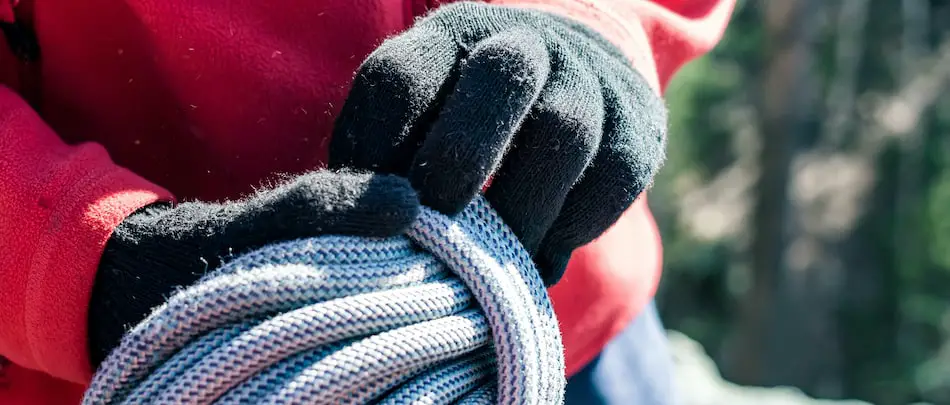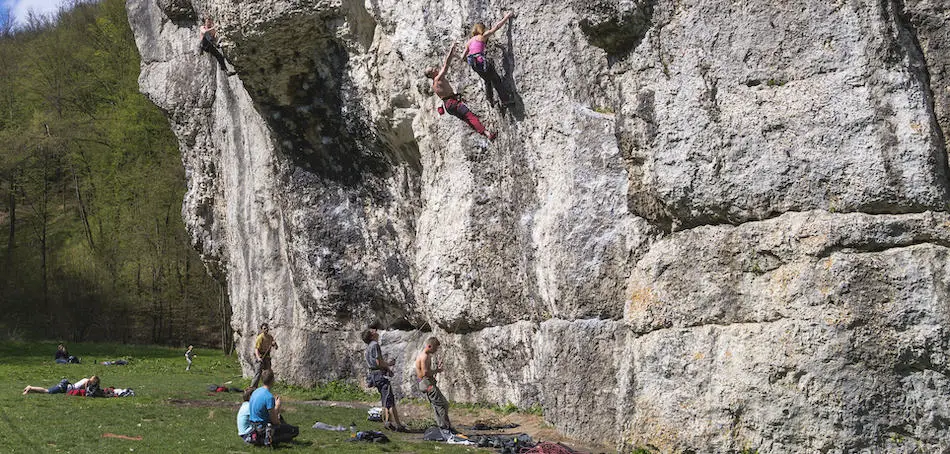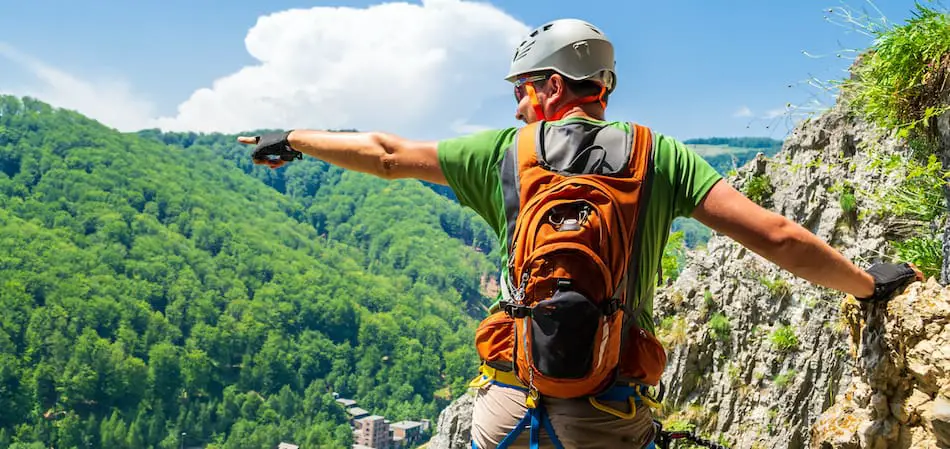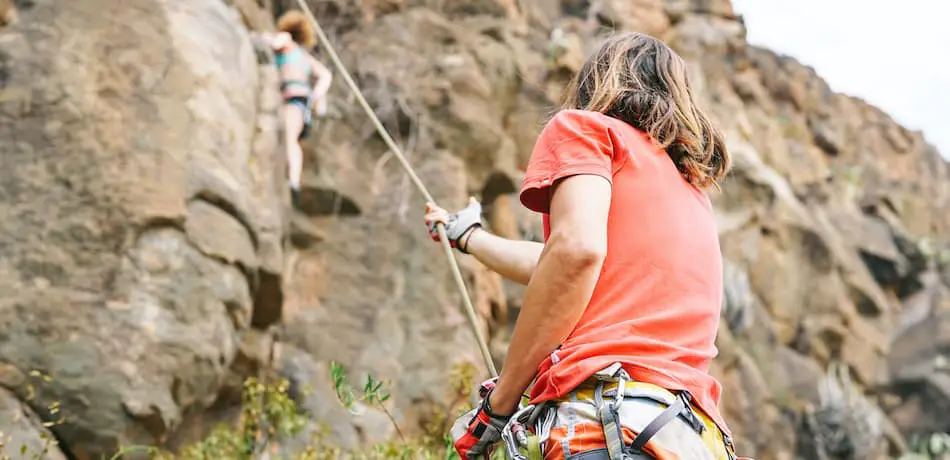
A question I get asked a lot is whether you should wear gloves while rock climbing. I wrote up this quick guide to help anyone who wants to get into the sport!
So, can you wear gloves while rock climbing? Yes, you can wear gloves, although most people don’t because it affects their ability to grip the rock.
While rock climbing in gloves certainly has some advantages, like protecting your hands from the rock, it also has a few downsides. Primarily among these is that you lose dexterity in your fingers, which is a major part of what makes you able to climb. Even the thinnest pair of gloves makes it difficult to perform simple tasks like tying your shoes; when you’re trying to find the right grip on a small rock ledge, it can be nearly impossible.
Why Most People Don’t Wear Gloves

When rock climbing, your ability to feel the rock with your fingers is maybe the most important determinant of your success. You need to be able to judge where it’s best for you to grip so you know when a handhold is secure enough to trust your weight with.
Once you’ve established that, you also need to be able to properly grip that handhold so you don’t fall off.
Unfortunately, gloves make it harder to do both of these things:
- When you’re searching for a handhold, they make your fingers less sensitive and make it harder for you to find where exactly you want to place your fingers.
- Once you do weight your hands, they make it harder to hold on. This is because gloves aren’t skin-tight; your hand will slip a little inside the glove, making your grip on the rock weaker.
So, for those two reasons, rock climbing in gloves isn’t always practical. There have been some people who’ve suggested created a glove specifically built for rock climbing (similarly to how there are shoes specifically built for the sport).
These gloves would be made out of some rigid rubber, and they would fit tightly to your hands so that you wouldn’t slip when grabbing a handhold. Theoretically, such a device could make it easier for you to hold onto small ledges, in the same way that shoes make it easier to stand on them.
However, this prototype hasn’t gained much popularity within the community. As I said, your fingers need a lot of dexterity when you’re climbing, and putting them in a stiff rubber glove would make that nearly impossible.
Now, some people will wear half-gloves while climbing; in fact, major equipment manufacturers like Black Diamond market these towards climbers. These allow you to keep your fingers free while covering your palms, which helps protect them from sharp rocks or rope burn.
The Arguments for Wearing Gloves

So, obviously, you don’t have to discount gloves in ever scenario. Although they may not be popular in the wide-spread climbing community, there are certainly some advantages to wearing them:
- Warmth
- Protection
- Better grip
Warmth
Warmth may not be a massive factor for anyone who’s climbing in a gym, but people who climb outdoors know how much it sucks trying to warm up your hands in-between routes when it’s a cold day.
Trying to grip cold rock with cold fingers sucks, and if your hands go numb, you’re going to lose all the sensitivity in them. Gloves are obviously designed to prevent this.
Protection
Again, this is more of a factor for people who are climbing outdoors. Rock can be sharp, and it can cut/scrape your hands to no end if you’re not careful. Even just brushing the rock the wrong way can skin up the back of your hand.
Wearing gloves creates an extra layer of protection that can lessen the damage done to your fingers. It’s happened to me before where I haven’t been able to hold onto a specific handhold because it’s too sharp and/or painful to do so. Gloves might have just done the trick.
Better Grip
Now, I need to preface this by saying this won’t be true in every scenario. In fact, as I said in the opening section, it’s probably not true in most scenarios.
However, sometimes — that is, with the right type of rock and the right type of glove — it may help with your grip. If you’re trying to grab a really smooth hold, for example, and your glove has rubber on the palm, you might find that you’re more able to grip it.
Situations in Which You May Wear Gloves

So, now that we know that gloves aren’t completely useless, what are some of the scenarios that you might wear them in?
Easy Climbing
As I said, the main drawback against gloves is that they ruin your ability to grip the rock. However, on easy climbing routes, you don’t need this ability as much, and so you’re able to enjoy the advantages of gloves without all of the disadvantages.
A scenario where this can be especially good is on something like a multipitch. Say you start out in the morning and it’s slightly chilly. You may keep your gloves on for the easier pitches lower down on the route, and then take them off once you reach the challenging climbing.
This protects your hands from getting injured prematurely.
Cold Conditions
Similar to what I was just saying above, when it’s cold, you may elect to wear a pair of gloves.
Now, I need to preface this by saying that it’s not always true. Lots of people go climbing in the cold because they want to send hard; the colder weather prevents them from sweating and lets them get a better grip on the rock. Obviously, in this scenario, gloves wouldn’t be good.
However, not everyone is out to climb as hard as possible. If it’s a chilly day or it’s late in the season and you just want to get out for a relaxing day at the crag, you might elect to throw a pair of gloves on so that you can be more comfortable while you’re climbing.
Crack Climbing
When you’re crack climbing, your finger sensitivity becomes less important, and protecting your hands becomes more important. In those conditions, gloves can do a lot of good.
Now, these aren’t normal gloves that you might wear on a hike. These are specially made crack climbing gloves that are designed to protect the palms of your hand while still keeping your fingers free to move.
Belaying
Lots of people wear gloves while belaying, and I would recommend doing so any time it’s cold or your hands are sore. These gloves protect you from rope burn and make sure that you’re always there to give your partner a good catch.
If you don’t want to wear the gloves while climbing, it’s easy to just slip them off and clip them to your harness when it’s your turn to go.
Rappelling
Rappelling is another situation where lots of people wear gloves. They allow you to more smoothly feed the rope through your hands without worrying about rope burn, much like rappelling.
Especially on multi-pitch routes, where you’ll have to perform several rappels in a row, it’s common practice to clip a pair to your harness or keep some in your backpack, and I would highly recommend doing so.
Climbing Gloves

Now, with everything I’ve said this article, it turns out that some companies like Black Diamond do sell gloves specifically marketed towards climbers. They’re half-gloves, which means they protect your palms against sharp rocks and rope burn while keeping your fingers free.
Personally, I don’t recommend wearing these gloves, because I think they leave you in a bit of an in-between area; the gloves don’t protect your fingers or keep them warm, while the leather palms can still mess with your grip and dexterity. They really just do half of a job.
Instead, I would say, pick up a good, tight-fitting pair of gloves and keep them in your crag pack for the occasions when you might need them. If you’re belaying, or you’re warming up on an easy route and it’s cold outside, go ahead and slip them on to keep your fingers from getting too damaged.
For the most part, though, climbing without gloves is the way to go!
